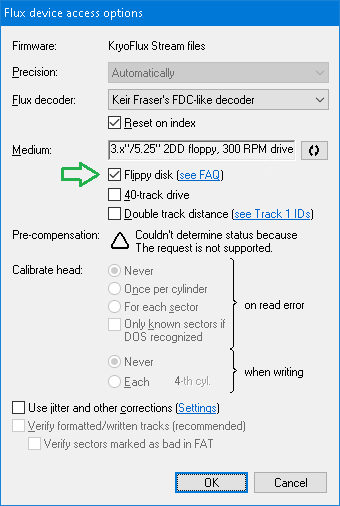Home ► RIDE ► FAQs ► Answer
RIDE soon to migrate to another web domain, announced in the new version of the application, while this web domain silently ceases to function! Please update your bookmarks/links once the new version of RIDE is out!
How do I create an image of a flippy disk?
Applies to: RIDE 1.7.3 and later
Flippy disks are two-sided floppies intended for single-sided drives – to work with the other side (reading/writing/formatting), one simply has to "flip" the disk over and plug it in "upside down". The following is an illustration of a such a disk, and note two index holes on either side.

Problems reading flippy disks on double-sided 5.25" drives:
- Head 1 (upper head) is by-design physically offset by eight tracks. It is therefore impossible to read upper Track 0 which is on flippy disks not offset by those eight tracks (but instead, of course, assumes the possition valid for Head 0).
- Head 1 captures the signal in reverse.
If you want to modify your double-sided drive to read flippy disks directly:
To be honest (and being quite clumsy), I have never in the slightest intended to modify any drive – so from my point of view, please take references to the tutorials only as a theoretical possibility.
- Modification of a Floppy Disk Drive for a Second Index/Sync-pulse Sensor (PDF)
If you now have a double-sided drive modified to read flippy disks directly:
Once you have modified the drive, simply tick the Flippy disk check-box (ALT+I) when accessing the drive, e.g. as below in the Access options dialog for the KryoFlux controller. By ticking the ckeck-box, the signal obtained from Head 1 will be reversed before decoding.

If you have a regular double-sided drive:
What I do is that I split the creation of a flippy disk into two separate dumpings, and then merge both parts into final image, as in the following.
- Plug the disk into a drive so that "Side A" faces Head 0.
- Access the drive using one of low-level devices, e.g. KryoFlux (see how). It is okay if the disk is not recognized.
- Create magnetic flux streams for each track on Head 0 (see how). Make sure Heads (Alt+H) is set to 1 in the Dump to destination dialog – only Head 0 is wanted. For simplicity, stick to the default naming pattern of track<cyl>.<head>.raw, e.g. track00.0.raw (mind both dots).
- When done, close access to the drive via Disk → Close.
- Flip the disk over in the drive so that now "Side B" faces Head 0.
- Access the drive the same way as above.
- Again, create magnetic flux streams for each track on Head 0 but save them this time into a different folder. For simplicity, create a subfolder SideB in the folder where you have already dumped "Side A" tracks; stick to the default naming pattern.
- When done, merge the two folders. Assuming you are switched to the folder with "Side A" that contains a subfolder SideB, type in the following command:
copy SideB\track??.0.raw track??.1.raw
- You have now a complete magnetic flux image of both sides that you can further work with, e.g. convert it to a more suitable image for emulation (see how).

